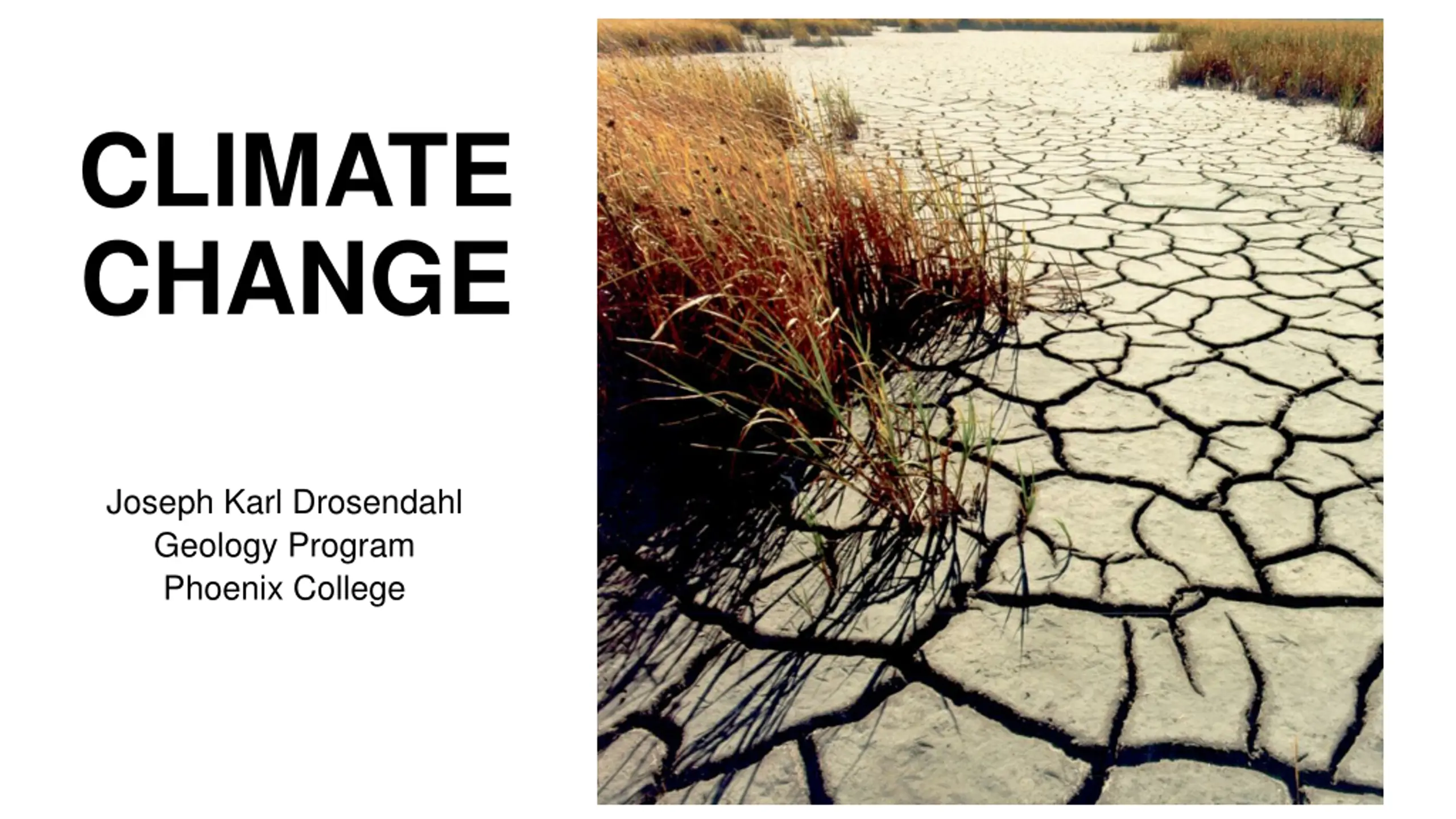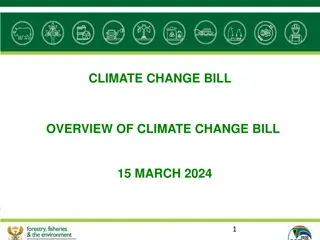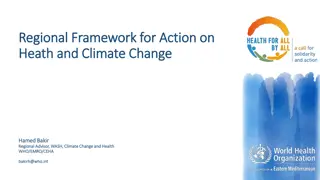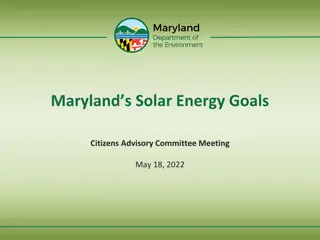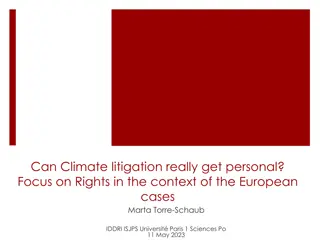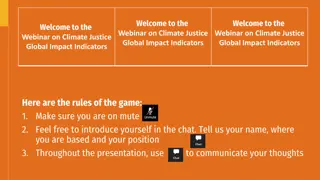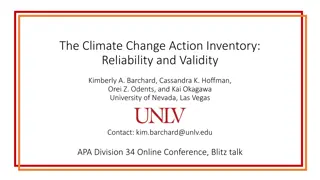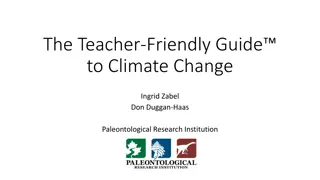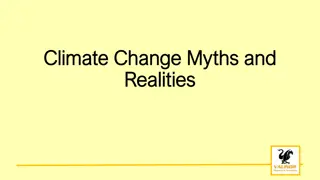Climate Change
Past and present factors affecting climate change, from natural phenomena like sun output and Earth's orbit to human activities. Delve into the potential causes such as greenhouse gases and meteor impacts.
Download Presentation

Please find below an Image/Link to download the presentation.
The content on the website is provided AS IS for your information and personal use only. It may not be sold, licensed, or shared on other websites without obtaining consent from the author.If you encounter any issues during the download, it is possible that the publisher has removed the file from their server.
You are allowed to download the files provided on this website for personal or commercial use, subject to the condition that they are used lawfully. All files are the property of their respective owners.
The content on the website is provided AS IS for your information and personal use only. It may not be sold, licensed, or shared on other websites without obtaining consent from the author.
E N D
Presentation Transcript
CLIMATE CHANGE Joseph Karl Drosendahl Geology Program Phoenix College
DEFINITIONS Weather: a daily condition of atmospheric events (i.e.: rain showers, wind direction, fog, snow amounts, etc.) Climate: long term (years) condition of atmospheric events. Global warming: the change in the yearly average of the world s temperature. Climate change: the long term (years) changes in atmospheric conditions, of which global warming is a part.
PAST CLIMATE CHANGE The Earth s climate has changed numerous times in the geologic past, and 5 times it caused mass extinctions. Climate change in the past has been influenced by several different events: Changes in the sun s output Changes in the earth s orbit Meteors impacting the Earth Natural changes in greenhouse gases levels
Currently there is another event that causes climate change: HUMAN ACTIVITY
CURRENT POTENTIAL CAUSES OF CLIMATE CHANGE The Sun: Changes in output The Earth: Changes in orbit (the Milankovitch cycles) which include: o The shape of Earth s orbit, known as eccentricity; o The angle Earth s axis is tilted with respect to Earth s orbital plane, known as obliquity; and o The direction Earth s axis of rotation is pointed, known as precession.
CURRENT POTENTIAL CAUSES OF CLIMATE CHANGE Meteor impacts: Results in decreased global temperatures due to material being ejected into the atmosphere. Greenhouse gases (increases global temperatures) Carbon dioxide Methane Nitrous Oxide Chlorofluorocarbons (human created) Water vapor
CURRENT POTENTIAL CAUSES OF CLIMATE CHANGE Natural Sources of Greenhouse gases o Volcanoes Volcanic ash: short term decrease in global temperature Greenhouse gases: increases global temperature o Plants (increases O2levels, decreases global temperatures) Human Source of Greenhouse gases o Use of fossil fuels (i.e., coal, petroleum & natural gas) increases greenhouse gases which increases global temperatures
WHAT IS CAUSING THE CURRENT CLIMATE CHANGE? Sun s output: current output is static or decreasing
WHAT IS CAUSING THE CURRENT CLIMATE CHANGE? Earth s orbit: oresults in long term climate changes, unlike current climate change. Volcanoes: ono great increase in current eruptions ocurrent volcanic eruptions produces 100 times less amount of CO2than humans
WHAT IS CAUSING THE CURRENT CLIMATE CHANGE? CARBON DIOXIDE LEVELS So, that leaves humans as the main cause of the current climate change, due to the use of fossil fuels.
CARBON DIOXIDE LEVELS AT MAUNA LOA, HAWAII
WORLD POPULATION GROWTH (Notice the similarity with the previous graph)
SEA LEVEL (caused by the melting of land ice)
EFFECTS OF CLIMATE CHANGE o Ocean temperature increase (feeds hurricanes, affects wildlife) o Ocean acidity increase (kills coral reefs) o Melting of permafrost (releases greenhouse gases) o Extreme weather: Hurricanes o More powerful due to increased ocean temperatures o Greater storm surge due to sea level rise Tornadoes (increased area of occurrence) Droughts Heat waves Floods o Food insecurity (higher food costs) o Increase in insurance costs or loss of insurance o Loss of life (heat, weather, starvation)
SOLUTIONS Twenty years ago, the personal effects of climate change were considered to be in the future, unfortunately the future is today. The effects of global climate change are now reported daily in the news. The change in our climate has not been fast and fixing climate change will take time. An appropriate analogy: the Titanic could not turn on a dime when it saw the iceberg. There are 2 types of solutions: o Mitigation: actions to reduce Greenhouse gas emission o Adaption: actions to react to Climate Change effects
MITIGATION Reducing the flow of greenhouse gases into the atmosphere, either by: reducing sources of these gases (ex.: burning of fossil fuels for electricity, heat, or transport) or enhancing the sinks that accumulate and store these gases (such as the oceans, forests (see next slide), and soil). The goal of mitigation is to: avoid significant human interference with Earth's climate, stabilize greenhouse gas levels in a timeframe sufficient to allow ecosystems to adapt naturally to climate change, ensure that food production is not threatened, and to enable economic development to proceed in a sustainable manner . (Source: 2014 report on Mitigation of Climate Change from the United Nations Intergovernmental Panel on Climate Change)
DEFORESTATION https://www.researchgate.net/figure/Modeled-Annual-Deforestation-Rates-from-1950-to-2009-in-Five-Year-Intervals-Rates- are_fig1_305744650
ADAPTION The goal is to reduce risks from the harmful effects of climate change. It includes making the most of any potential beneficial opportunities associated with climate change (example: longer growing seasons or increased yields in some regions). While climate change is a global issue, it is felt on a local scale. Cities and local communities are focusing on solving their own climate change problems. building flood defenses, planning for heat waves and higher temperatures, installing better-draining pavements to deal with floods and stormwater, and improving water storage and use.
RESPONSE TO CLIMATE CHANGE DIS-BELIEVERS o Climate change has happened in the past so it s no big deal. That s true but it occurred for reasons that don t exist today. o Climatologist don t agree 100% on the cause of climate change. 97% of climate scientist agree that humans are the major cause of climate change. Consider that 100% of politicians don t have the same political views, and doctors don t agree 100% on the best way of treating cancer; but we still have new laws and patients being cured of cancer. o It would cost too much to mitigate climate change. Not doing anything will be more costly (i.e.: increased insurance costs, loss of insurance, higher food prices, loss of infrastructure, etc.)
WHAT YOU CAN DO o Consider your carbon footprint: A carbon footprint is the total amount of greenhouse gases that are generated by our actions. The average carbon footprint for a person in the United States is 16 tons, one of the highest rates in the world. (https://www.nature.org) Carbon footprint calculator: https://www.nature.org/en-us/get-involved/how-to- help/carbon-footprint-calculator/ o Consider alternative sources of energy: Solar cells Wind generators Electric/hybrid cars o Be careful who you vote for in all elections (local, state & federal).
RECOMMENDED WEBSITES National Aeronautics and Space Administration (NASA): https://climate.nasa.gov/ Environmental Protection Agency (EPA): https://www.epa.gov/climate-change United States Geological Survey (USGS): www.usgs.gov/science/science-explorer/climate Skeptical Science: https://skepticalscience.com/
REFERENCES Information and graphics: climate.nasa.gov Title photograph: USGS.gov Others as noted.
